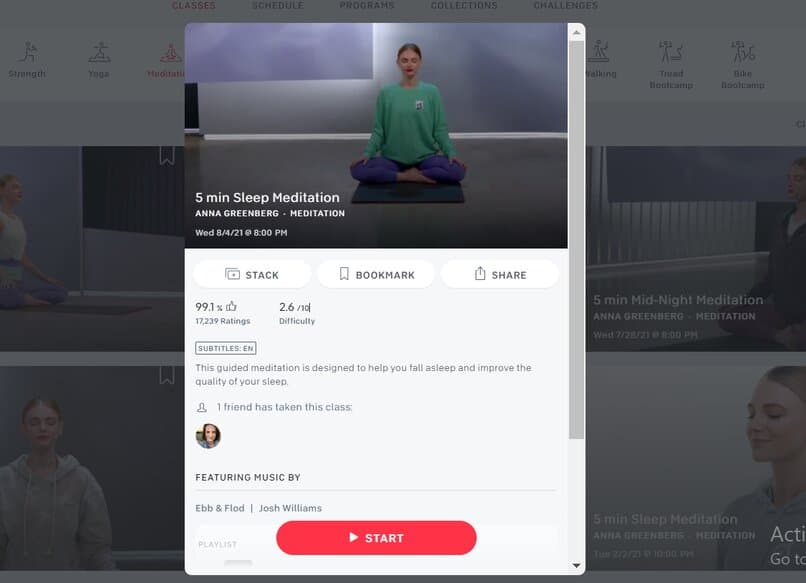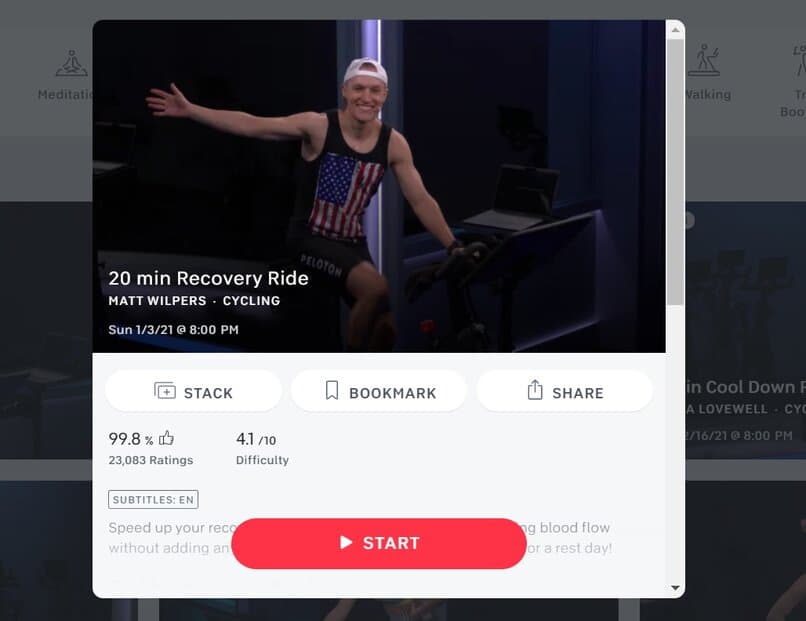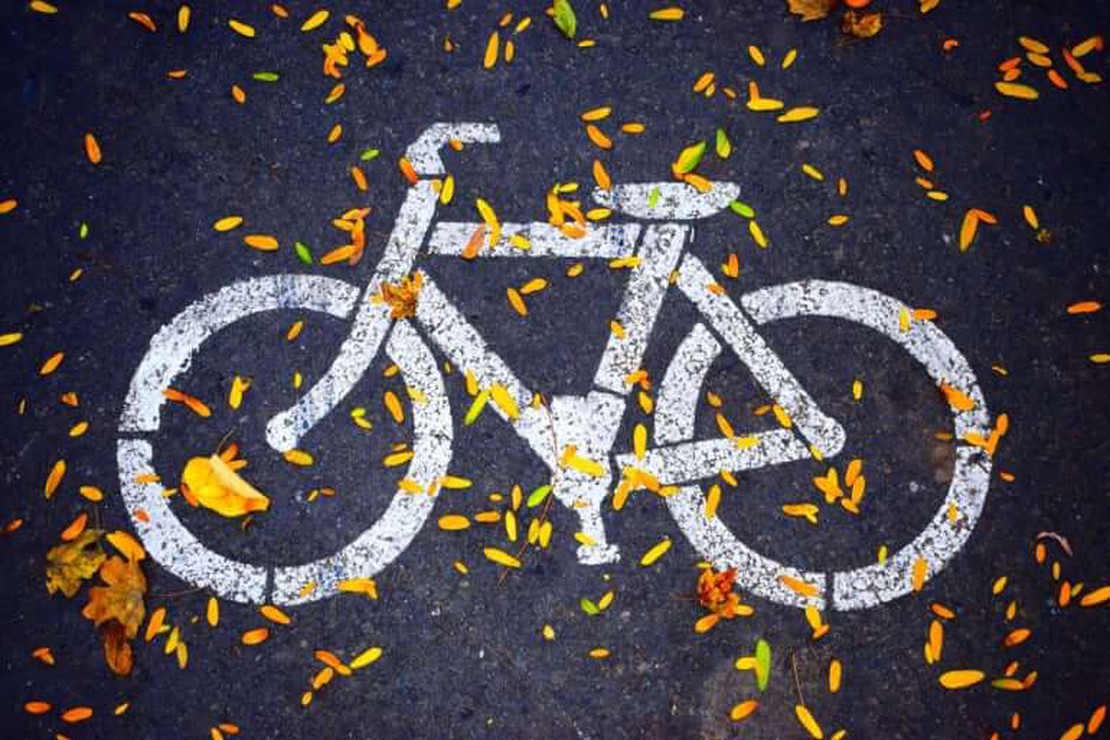Reduce Post-Workout Soreness & Heal Your Body with These Peloton Recovery Classes
Intensive workouts can cause tissue and injury. It is important to take a break from intense workouts for a few days or to do a low-impact, not too demanding, workout.
Peloton Instructor Matt Wilpers recommends that you spend at least one day avoiding the difficult challenges of the tread, bike, or dumbbells.
Sometimes all you need is a ride for recovery. Or do a restorative yoga class. You can also take a day off from your Peloton.
Recovery classes are designed to help your body heal, rest, and give you the energy to pick up from where you left off. Let’s learn more about Peloton recovery tips and top-rated Peloton recovery classes.
Active engagement is not enough for your fitness journey. Rest and recovery are equally important. Have you ever noticed that at the end of a Peloton ride, the instructor states that your descending recovery is the most important?
What do I need right now? Rest, Recovery or Restorative classes?
I am currently focusing on rest, recovery, and restorative classes. Three reasons have led me to be more conscious of the needs of my body.
One, I am continuing to follow the Hardcore on the Floor schedule. This means that I am doing glutes and legs classes at minimum twice per week, upper body classes twice per week, and barre and pilates twice per week.
Two, I have decided to take on the Tunde Arm Challenge. That’s three arms and light weights classes with Tunde, each week. Three, I recently fell on my left side. So, I’m sore.
I didn’t break anything. I think my strength training helped my bones. I want to be active, but not push it too hard or do anything stupid. It is important to take recovery rides, have rest days, and practice restorative yoga.
When Should You Take Peloton Recovery Classes?
There is no one right way to take a recovery class. It all depends on how you feel. First, listen to your body and let it know that you need a day off. Next, give it a low-intensity workout or a relaxing massage.
If you are going through something difficult, you can do a recovery exercise.
Types of Recovery
There are two types, active and passive, of recovery.
Passive Recovery
Passive recovery is a period of time where you are not engaged in any type of workout, high or low impact. You don’t even need to walk or do any other activity.
You can, however, sleep longer or get a therapeutic massage. Peloton meditation is a passive recovery activity. It takes between 5 and 15 minutes and commits your mind emotionally and mentally mindful, rather than physically.
Two of my favorite meditation classes for passive healing are
[Meditation for Better Sleep: 5 Minutes Sleep meditation with Anna Greenberg

It is something I am very aware of how important sleep is to passive recovery. Before I go to bed, I attend a 5-minute sleep meditation class.
It helps me to unwind the difficult days or weeks I have had. Anna guides you through the meditations in a cool way that promotes better sleep and reduces stress.
[Breathing Meditation: 5 Minutes with Chelsea Jackson Roberts

Sometimes, all you need to feel better is your breathing. Yes. You’ll be amazed at how much baggage you can take off your shoulders by taking 5 minutes off of everything else in the world.
You get the feeling that nothing matters and your mind drifts in its fantasies. Your recovery is greatly enhanced by the peace and quiet that your mind offers.
Active Recovery
Passive recovery sounds great, but it is not for everyone. Some people feel that they will die if they do nothing. Sometimes, you might need to speed up your recovery by doing a low-impact exercise.
Active recovery is important because it helps to prevent those dreadful lactic acid periods that can make your day more difficult than restful.
Active recovery is the best option for these reasons. You can then go for a low impact run or ride, stretching, yoga, or any other activity that is clearly low-impact. Peloton offers many options for all of these options. Let’s dive in to the most incredible of them.
Active recovery is a different level of recovery rides. These rides fall under the power zone ride category, and specifically power zone endurance rides.
Christine D’Ercole, for example, has taught Power Zone endurance (PZE) rides that are all in Zone 2. These Power Zone rides are among the most enjoyable, because Zone 2 is sneaky. Although you don’t feel like you’re doing a lot, suddenly you find that you are sweating a lot. This is a great way for you to sweat without getting too hot.
According to the power zone meter, Zone 1 technically means active recovery. If you want, you can take a Power Zone Endurance Ride and do the entire thing in Zone 1 or Zone 2.
A 30-minute endurance ride in the power zone at a lower zone would be a great way to recover.
[Peloton Recovery Ride: Matt Wilpers 20-Minute Ride

Matt Wilpers offers a recovery class that keeps blood flowing high, even though it is a rest day. Ironically, he incorporates hip-hop in the workout, which would make it more intense.
You may find yourself in meditation while riding, as Wilpers suggests. You will enjoy a slow ride that sets the pace and allows you to do low-impact activities.
[Restorative Yoga: 10 Minutes with Ross Rayburn

Although Ross Rayburn’s yoga session is geared towards passive recovery, the stretches are definitely active recovery.
Rayburn helps you to relax, focus more on your well-being, and stretch your joints and muscles. Yoga actually helps you recover. Yoga improves your sleep patterns, which is crucial for constructive recovery.
[Short Warm-Ups: 5 Minutes with Alex Toussaint
A warm-up session is a great option if you don’t want to ride but are unable to bear the thought of soreness from lactic acids build-up. Although the warm-ups last only 5 minutes,
Alex Toussaint has a way to incorporate great music tracks and recovery rides. Warm-ups can give you the energy and refreshment that you need. You will feel energized and happy no matter how long you take off from your workouts.
[Peloton Walking: 30 Minutes with Andy Speer
You can choose to go outside or indoors for your Peloton walk. Outdoor peloton walks are a great option for recovery. It adds a fresh air to the equation which helps clear the mind.
It is very impressive to walk with
Andy Speer. This is your normal walk, but you have a guide along with you.
Peloton music is available to keep your mind and ears busy during the workout.
The walk is a great way to stretch your muscles and prevent post-workout inflammation. It also keeps you from doing high-intensity exercises.
[Intervals Run: 20 Minutes with Becs Gentry
This class is great for active recovery if you have a Peloton treadmill. It is too short for the tread which is why it is called a recovery class.
The workout is also not as intense than most treadmill classes, making it a great choice for beginners and advanced users alike.
How to find a Peloton recovery ride?
It is now easier to locate Peloton recovery rides, thanks to the expanded search function of Peloton. Search the website or bike and enter “recovery ride”.
Because there are also recovery runs, I recommend that you include the word “ride” in your search. I want you get the best search results. In a moment, I will talk about recovery runs.
Search is a better option than the class filter. Recovery rides are not available in the “Class Type” option. Two of them, however, are included in the filter’s low-impact class type. You can see the difference.
However, the search results I get when I use my computer to do this search return 37 results. They are listed below in reverse chronological order.
Peloton Recovery Rides vs. Low Impact
Peloton offers low-impact rides when you search for rides. What is the difference between a recovery and low-impact ride?
What are low-impact rides?
Let’s begin with low-impact rides. Low-impact rides are those that are mostly done in the saddle. Because you don’t get out of the saddle, you won’t be standing, dancing, or running. These rides are much easier for your joints.
Low-impact rides don’t have a low heart rate. Even if you are sitting down, a low-impact ride can still be very intense. A climb done in the saddle may be considered low-impact, even if it makes you sweat.
Matt Wilpers has a number of low-impact rides that you can consider if you are determined to go on a ride. Low-impact rides are often based on pedal work. For example, you can pedal with one leg only. These exercises can help you become a better rider.
What are Recovery Rides?
These rides allow your body to recover and still get in a ride. It is possible to consider cool-down rides after exerting yourself hard as a recovery ride.
As I have already explained, Peloton offers legitimate recovery rides. These rides serve a purpose: to help your body heal.
Here’s how Peloton describes Recovery Rides:
You can speed up your recovery by flushing your legs and increasing blood circulation without adding stress to your muscles. This ride is ideal for a rest day !"
Cool down rides are another type of ride that could be used to mimic recovery rides. These rides last between five and ten minutes, and they are all about getting your legs flushed.
Peloton Recovery Runs
After I’ve talked about recovery rides, let me now talk about Peloton’s recovery runs. The Peloton search tool will allow you to find recovery runs in the same way as the rides.
You’ll find 51 results when you type “recovery run” into your search box. These include those who are in the studio with Tread instructors and go back to early 2019.
Peloton Restorative Yoga
I mentioned above that Ross Rayburn has a five-minute class on yoga under “recovery.” But did know that there is a whole branch dedicated to yoga that is focused on recovery? This is called restorative yoga and Peloton offers many classes on this topic.
Here’s how Peloton describes their restorative yoga classes.
Restorative yoga uses props to help take the strain out of poses and allows for more relaxation. Relax, calm your nervous system, and you will feel restored ."
What to do during a Peloton rest day and recovery day?
Active recovery days are one of the reasons why I love the Hardcore On the Floor calendar. The calendar does not include active recovery classes.
The calendar will also include an outdoor walk via the Peloton app every Sunday. It will also include a shorter yoga sequence that focuses on one body part such as your hips and hamstrings.
Any activity that is low-impact counts as a rehabilitation activity. Walking your dog while you listen to music or stretching is a great way to recover from a Peloton class. A rest day is a great opportunity to try out the Peloton chair and standing yoga.
More standing classes are available from Peloton.
Final thoughts
Pelotons make it easy to go overboard. Over exercising can happen even if you only use the Peloton App. This tool is accessible 24/7, so there’s no reason to not exercise.
But, recovery and rest are as important as sweating. Your body requires time to heal.
If you feel like you are reaching a plateau in your exercise or you’re not getting PRs, it may be time to stop doing so. This doesn’t mean that you shouldn’t be active. You just need to do it in a more recovery-oriented way.
Peloton offers restorative classes that make up for the class’s high intensity. The classes are available at any time you need them. You don’t have to miss work to attend a restorative class. They are great for helping you relax and boost your sleep.

